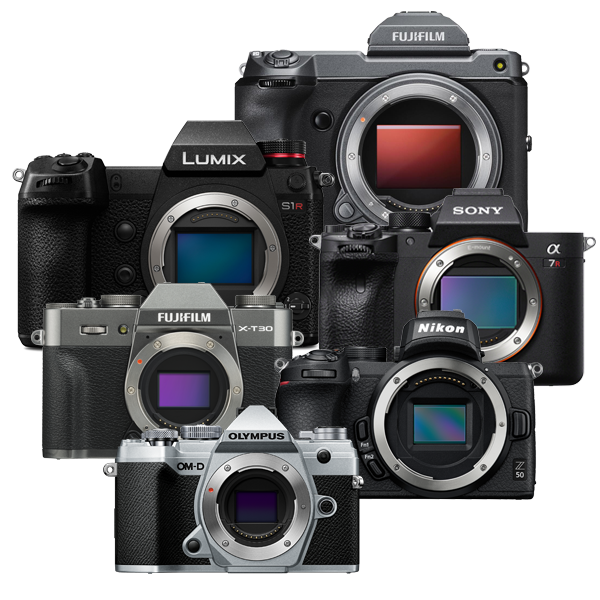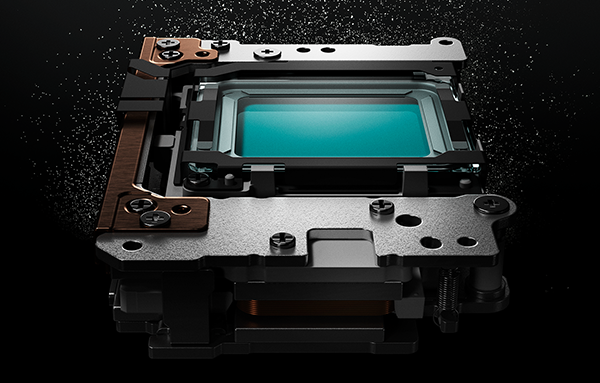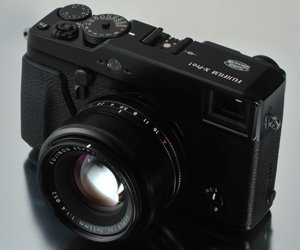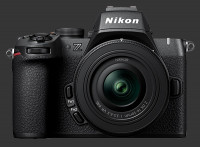 Mirrorless Camera Guide 2024
Mirrorless Camera Guide 2024
Mirrorless Cameras
When Panasonic and Olympus jointly launched the Micro Four-Thirds platform to produce high-image quality in a compact form-factor in 2008, these new Mirrorless Digital Cameras triggered a revolution in the industry. Suddenly, two companies that had an insignificant DSLR market share, led the fastest growing digital camera segment. With each next generation, Mirrorless Digital Cameras improved and eventually delivered on their promise, prompting virtually every other manufacturer to join with new systems, sometimes more than once. In the last two years, over 3X more mirrorless cameras were introduced than DSLRs , the symbol of image-quality for the last 2 decades, and just one more fixed lens cameras than mirrorless was launched.
This Mirrorless Camera Buying Guide explains what mirrorless digital cameras are, their advantages, the different types that exist and how each mirrorless system compares since these are system cameras compatible with certain lenses. Given that much had changed in the last two years, this mirrorless buying guide was completely rewritten in 2020. There are considerably more differences between mirrorless systems than among DSLR systems.

Origins
A mirrorless camera is an interchangeable lens camera without a reflex mirror, just like a car is a horseless carriage. Until mirrorless cameras were invented, digital cameras with interchangeable lenses all had a single lens and a mirror to reflect light towards an optical viewfinder. Such camera is called a DSLR which stands for Digital Single Lens Reflex. Mirrorless cameras also have a single lens but no mirror which allows its lens to be mounted closer to the sensor yet prevents them from having an optical reflex viewfinder.
Originally, the term SLD, which stands for Single Lens Digital, was used but made it easy to confuse with SLR. To further confusion, at least one manufacturer called their mirrorless cameras DSLRs! In the end, the more descriptive mirrorless name was broadly adopted, including here at Neocamera. The term DSLR is exclusively used for cameras with a Reflex optical viewfinder and the term ILC refers to both DSLR and Mirrorless.
Parallel to this revolution, cellphones improvements caused the digital camera market to implode. Compact digital cameras that delivered mediocre image-quality in a convenient size were supplanted by cellular phones which can be described the same way. This made mirrorless digital cameras a necessity to offer high image-quality in the most compact form-factor given that DSLRs were considered too large for anyone but professional photographers.

Mirrorless Image Quality
Fast forward to 2020 and mirrorless digital cameras are now capable of exactly the same image quality as DSLR. Among the top 10 cameras with the best image-quality, six are mirrorless. Among the top 20, nine are. The simple reason is that the same sensor technology is used across all these models, technology made by Sony which manufactures more than 50% of sensors on the planet and has been a leader in image-quality.
While technology constantly improves, the most significant factor for image-quality is sensor-size. All else being equal, a larger sensor will always deliver better image quality since it gathers more light than a smaller one. DSLRs mostly use APS-C and Full-Frame sensors, except for Medium-Format used in by Pentax. The image-quality from a modern APS-C sensor is excellent with Full-Frame and Medium-Format sensors delivering even better performance. All these sensor-sizes are used inside mirrorless cameras too.






Mirrorless digital cameras also use Four-Thirds sensors which are smaller than APS-C and exactly 1/4 the surface area of Full-Frame sensors. While they cannot completely match the image-quality from larger sensors, their output is very good and this smaller size brings other advantages. Two smaller sensors-sizes were previously used by mirrorless cameras, 1" and 2/3", but no such camera has been produced in the last 5 years.
The diagram shown on the right shows sensor sizes used among current mirrorless cameras. All rectangles are to scale and even coincide with actual sizes on most computer displays. There are actually two very similar variants of APS-C with the one used by Canon being fractionally smaller.
Mirrorless Camera Size
The size of mirrorless cameras varies tremendously, from highly-compact Micro Four-Thirds models to huge Medium Format ones that exceed the size of DSLRs. With a given sensor-size, a mirrorless camera can be made smaller than a DSLR, yet some manufacturers chose to deliver more capabilities within the same size rather than go smaller. The main size saving comes from the depth of the camera body since there is no need to leave room for a swinging mirror. Some height can also be saved by moving the viewfinder or using a more compact unit which has to be done carefully for ergonomic reasons.
A camera needs a lens in order to form an image. While there is a clear focus on camera size, it is crucial to understand that total bulk depends on both the camera and lens. Removing the mirror allows cameras to be made significantly smaller but it has minimal impact on lens size. Designing optics is a complex science. While certain lenses can be made smaller when designed specifically for a mirrorless camera, generally the size of optics is mostly determined by sensor-size. This is exactly why compact cameras have small lenses that correspond to their small sensors. The same applies to cellphones. Even weight saved is minimal since most the size-reduction comes from moving relatively empty space within the camera.
All this means that a mirrorless camera and matching lens can only be somewhat smaller than a DSLR having the same sensor-size. In the best case, a Full-Frame Mirrorless manages to compare in size to an APS-C DSLR when including equivalent lenses. This makes for some fairly small APS-C mirrorless camera and lens combinations with the greatest advantage for the Micro Four-Thirds system.
Mirrorless vs DSLR
Given the promise of high-image quality and being interchangeable lens cameras, people ask most frequently: How Mirrorless Digital Cameras compare to DSLRs? Since technology improves at such a rapid pace, the answer changes just as quickly. Below is a list of differences between mirrorless cameras and DSLRs in 2024. Misconceptions exist because these were not all true several years ago and so the list below applies to current mirrorless cameras compared to current DSLRs.

Top 10 Mirrorless vs DSLR Facts
 Image quality from a mirrorless and a DSLR with a sensor of the same size is completely equivalent. Such cameras often use the same sensor nowadays. There are no longer Four-Thirds DSLRs yet the output from Micro Four-Thirds cameras is comparable to that of APS-C DSLRs at common print sizes.
Image quality from a mirrorless and a DSLR with a sensor of the same size is completely equivalent. Such cameras often use the same sensor nowadays. There are no longer Four-Thirds DSLRs yet the output from Micro Four-Thirds cameras is comparable to that of APS-C DSLRs at common print sizes. A lens impacts the image quality of a mirrorless camera just like a DSLR. The best output can only be obtained with a sufficiently sharp lens which excludes typical kit lenses, that are built for low-cost and compactness, sold along with cameras.
A lens impacts the image quality of a mirrorless camera just like a DSLR. The best output can only be obtained with a sufficiently sharp lens which excludes typical kit lenses, that are built for low-cost and compactness, sold along with cameras.  Autofocus performance improved the most since their invention. They show minimal differences with DSLRs in terms of speed and sensitivity. Autofocus performance drops in low-light, just like a DSLR. Since mirrorless cameras compute focus on-sensor, they cannot have front or back-focus issues.
Autofocus performance improved the most since their invention. They show minimal differences with DSLRs in terms of speed and sensitivity. Autofocus performance drops in low-light, just like a DSLR. Since mirrorless cameras compute focus on-sensor, they cannot have front or back-focus issues. The maximum continuous shooting speed of mirrorless cameras is considerably faster than any DSLR. Up to 60 FPS or 20 FPS with Continuous AF is possible at full-resolution and so are ultra-fast shutter-speeds exceeding 1/8000s. High-end mirrorless cameras even offer a black-out-free view.
The maximum continuous shooting speed of mirrorless cameras is considerably faster than any DSLR. Up to 60 FPS or 20 FPS with Continuous AF is possible at full-resolution and so are ultra-fast shutter-speeds exceeding 1/8000s. High-end mirrorless cameras even offer a black-out-free view. Mirrorless cameras are quieter than DSLRs since there is no reflex mirror moving between frames. Most have a completely silent mode that uses an electronic-shutter. This is a major advantage for photography in quiet environments.
Mirrorless cameras are quieter than DSLRs since there is no reflex mirror moving between frames. Most have a completely silent mode that uses an electronic-shutter. This is a major advantage for photography in quiet environments. The most significant difference between a DSLR and a mirrorless is the preview. Entry-level mirrorless cameras have no viewfinder nor provision to add one, while the best offer a huge EVF beyond the sharpness of a retina with an Exposure-Priority preview. All mirrorless show 100% coverage.
The most significant difference between a DSLR and a mirrorless is the preview. Entry-level mirrorless cameras have no viewfinder nor provision to add one, while the best offer a huge EVF beyond the sharpness of a retina with an Exposure-Priority preview. All mirrorless show 100% coverage. Mirrorless cameras consume significant power since their sensor must be powered continuously to generate the preview, except for the Fujifilm X-Pro series with their hybrid viewfinder. Their average battery-life is 370 shots-per-charge, compared to 990.*Based on current models as of January 2020.
Mirrorless cameras consume significant power since their sensor must be powered continuously to generate the preview, except for the Fujifilm X-Pro series with their hybrid viewfinder. Their average battery-life is 370 shots-per-charge, compared to 990.*Based on current models as of January 2020. Video features are more advanced on mirrorless cameras since the constant preview is basically a continuous video stream from the sensor. This makes it possible to record video with the camera at eye-level and use continuous Phase-Detect AF while filming.
Video features are more advanced on mirrorless cameras since the constant preview is basically a continuous video stream from the sensor. This makes it possible to record video with the camera at eye-level and use continuous Phase-Detect AF while filming. Most recent mirrorless cameras feature built-in image-stabilization, called IBIS, with efficiency from 5 up to 8-stops over hand-holding Not only is this superior to optical stabilization in any lens, it also applies to all lenses, including adapted ones. Only Pentax DSLRs have in-body stabilization.
Most recent mirrorless cameras feature built-in image-stabilization, called IBIS, with efficiency from 5 up to 8-stops over hand-holding Not only is this superior to optical stabilization in any lens, it also applies to all lenses, including adapted ones. Only Pentax DSLRs have in-body stabilization. A mirrorless can be made more durable than a DSLR, due to fewer moving parts. There are many professional weatherproof models and some are freezeproof which only Pentax DSLRs are. At the extreme end of the spectrum, Nikon made a waterproof mirrorless while no such DSLR exists.
A mirrorless can be made more durable than a DSLR, due to fewer moving parts. There are many professional weatherproof models and some are freezeproof which only Pentax DSLRs are. At the extreme end of the spectrum, Nikon made a waterproof mirrorless while no such DSLR exists.

SLT - Mirrorless with Pellicle Mirror
Sony made multiple attempts to overcome limitations of mirrorless cameras. Before the on-sensor Phase-Detection technology pioneered by Fujifilm became widely used, Sony created hybrid cameras that used a semi-transparent mirror to reflect about 30% of light towards focus and metering sensors. They called these SLT cameras for Single Lens Translucent. Contrarily to a DSLR, an SLT has an EVF that previews exposure, color, white-balance and focus, up to its maximum resolution. This gave them fantastic advantages which were unmatched at the time, however these cameras had to be comparable in size to DSLRs due to the semi-transparent mirror.
Next
Proceed to Step 2 to learn How to Choose a Mirrorless Camera & System. This explains different types of mirrorless cameras and the types of photography they work best for.
Please Support Neocamera
All information on Neocamera is provided free of charge yet running this website is a huge endeavor. Purchases made via affiliate links found throughout the site help keep it running and up-to-date. There is no additional cost to you, so please consider buying via these links to our affilates:
If you found any information on this site valuable and did not purchase via our affiliate links, please considering donating via PayPal:
Any amount will be greatly appreaciated. Thank you for your support!
New Cameras & Lenses

Sony FE 50-150mm F/2 GM
Weatherproof
Sony E Mount Zoom
2025-04-22
Nikon Z5 II
24 Megapixels Mirrorless
Nikon Z Lens Mount
Built-in Stabilization
Weatherproof
2025-04-03
Canon RF-S 14-30mm F/4-6.3 IS STM PZ
Stabilization
Canon RF Mount Zoom
2025-03-26
Canon RF 20mm F/1.4L VCM
Weatherproof
Canon RF Mount Prime Lens
2025-03-26
Canon EOS R50 V
24 Megapixels Mirrorless
Canon RF Lens Mount
2025-03-26
Venus Optics Laowa 14mm T/2.6 Zero-D VV Cine
Sony E Mount Prime Lens
2025-03-25
Updates
2025.01.18

Fujifilm GFX 2025 Lens Roundup
Lens Review roundup of Fujifilm GFX Medium-Format lenses. Quality, performance and handling of the GF20-35mm F/4R WR, GF30mm F/3.5 Tilt-Shift and the GF55mm F/1.7.
2024.11.18

Best 2024 Photography Gifts for Every Budget
Great gifts for photographers and photo enthusiasts selected for every budget among the best products of 2024.
2024.08.07

Eye Protection Tips for Professional Photographers
The four main considerations for professional photographers regarding eyewear.
2024.07.14

Fujifilm X100VI Review
Flagship fixed-lens compact digital camera with a 40 MP sensor and Image-Stabilization, a first for the series. Retro design featuring dual control-dials, plus direct ISO, Shutter-Speed and EC dials. Its hybrid viewfinder can switch between EVF and OVF mode.
2024.05.09

Fujifilm GFX100 II Review
Flagship 102 Megapixels Medium-Format Mirrorless Digital Camera with 8-Stop 5-Axis IBIS, 8 FPS Drive, 8K Video and 400 MP Super-Resolution capture in a weatherproof and freezeproof body with dual control-dials and dual memory-card slots.
2024.04.03

Fujifilm X-T5 Review
Newest Fujifilm flagship boasting a 40 MP APS-C sensor, 5-axis IBIS with 7-stop efficiency, 15 FPS continuous drive, 6.2K Video capture, dual control-dials and dual SDXC UHS-II slots in a sturdy weatherproof and freezeproof body.
2023.11.20

Best Digital Cameras of 2023
Find out which are the Best Digital Cameras of 2023. All the new Mirrorless Digital Cameras from entry-level to high-end professional.
2023.07.10

Fujifilm X-H2 Review
40 Megapixels APS-C Hybrid Mirrorless Digital Camera with 7-stop IBIS. Fastest shutter ever and 8K video capture. Large builtin EVF with 0.8X magnification and 5.8 MP, plus an Eye-Start Sensor. Packed with features and large number of controls in a weatherproof and freezeproof body.
2023.05.07

Sony FE 20-70mm F/4G Review
Review of the unique Sony FE 20-70mm F/4G lens. The optical zoom of this lens spans ultra-wide-angle and medium focal-length coverage, making it one of the most versatile Full-Frame lenses on the market.
2023.01.15

Huion Inspiroy Dial 2 Review
Review of the Huion Inspiroy Dial 2 tablet, a medium sized drawing surface with dual dials and customizable buttons. Connects via USB-C or Bluetooth 5.0 with Windows, Linux and Android support.
2022.12.08

How to Pack for a Photo Trip
Find out how to pack for a travel photography trip, carry your gear safely while meeting airline regulations.
2022.11.13

Best Digital Cameras of 2022
The best digital cameras of 2022. A short list of the most outstanding models in their respective categories. Choose one for yourself or as a gift.









